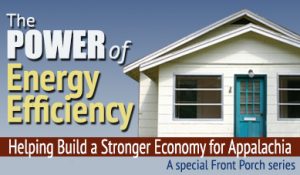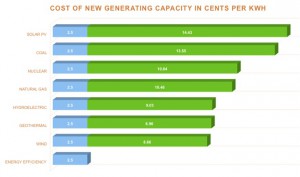Front Porch Blog
{ Editor’s Note } This is the final installment in a five-part series illustrating the need for greater investments in residential energy efficiency as an economic driver in rural Appalachia. In this post, we describe the efforts of Appalachian Voices and our allies in helping Appalachia realize its energy efficiency potential, and highlight some of the successes that have already been achieved.

- Part 1: How Energy Efficiency Can Help Alleviate Poverty
- Part 2: The Need for More Economic Diversity in Appalachia
- Part 3: How Energy Efficiency Can Help Diversify Local Economies in Appalachia
- Part 4: Why Rural Electric Cooperatives Should Provide Financial Support for Home Energy Efficiency Improvements
- Part 5: What Appalachian Voices and Our Allies Are Doing To Help Appalachia Realize Its Energy Efficiency Potential
Energy efficiency might not be the cool kid in the room to most people. That would be solar energy, smug ole solar). Energy efficiency is the smart kid sitting in the back of the room, the one that quietly goes about its work, that gets more done with less effort. It even helps solar succeed, because without energy efficiency, a whole lotta solar energy gets wasted, rendering it less economical compared to the fossil fuel bullies in the room.
But the fact that energy efficiency helps solar with its homework isn’t why it is exciting and important. Energy efficiency provides so many benefits beyond just serving as the cheapest way to meeting our energy demands (approximately 80 percent cheaper than solar). Energy efficiency helps alleviate poverty, creates and sustains local jobs, and promotes local economic development. It makes homes more comfortable and healthy, and reduces the environmental impact associated with our energy use. It also may be the most vital solution to Appalachia’s energy and economic future, as we’ve described in this blog series.
Yeah, solar does almost all of these things (and don’t get me wrong, solar energy is still awesome), but energy efficiency costs a lot less to achieve the same benefits, meaning it can have a much greater impact per dollar. In Appalachia, as in other regions of the U.S. where public and private investment in clean energy is relatively scarce, this is an important consideration, and it’s one of the main reasons why Appalachian Voices initiated our Energy Savings for Appalachia program last year.
Through this campaign, we are actively promoting cost-effective solutions that will help Appalachia realize its energy efficiency potential while maximizing the economic and environmental benefits along the way. And the potential is mind-blowing. A 2009 study on Appalachia’s energy efficiency potential found that an investment of $7 billion in residential efficiency improvements would save Appalachian families nearly $14 billion in energy costs by 2030, reducing the average home’s energy use by more than 15 percent and (based on the employment impact multiplier used in this study) creating more than 100,000 jobs in the process. This illustrates how, for a region made up of largely impoverished communities and families, energy efficiency could provide a significant economic boost and help reverse a long-standing struggle to develop and strengthen local economies in the region.
This is why Appalachian Voices and many of our allies have dedicated ourselves to promoting strong investment in cost-effective energy efficiency programs in Appalachia. We are working with rural electric cooperatives to develop home energy efficiency finance programs like those we’ve described in this series. We are inspired and joined in this work by our regional partners and allies, which include the Mountain Association for Community Economic Development (MACED) (Kentucky), the Southern Alliance for Clean Energy (North Carolina and Tennessee), Statewide Organizing for Community eMpowement (Tennessee), Southeast Energy Efficiency Alliance (SEEA) (regional), Kentuckians for the Commonwealth (Kentucky) and Environmental Defense Fund (EDF) (North Carolina). Recognizing the need and potential for improving energy efficiency in rural areas, each of these organizations are focused in part on working with the rural electric cooperatives that provide electricity to those communities.
As a result of the efforts of many of these organizations, there have been some key successes, and there is now a growing movement in Appalachia toward the development of financing programs for residential and commercial energy efficiency. Leading the way was MACED, which spearheaded the development of the successful and still-growing How$mart Kentucky program. In North Carolina, EDF helped with the development and launch of a pilot on-bill finance program through Roanoke Electric Cooperative. And just recently, SEEA launched the Southeast Energy Efficiency Finance Network, which aims to facilitate the expansion of public and private investment in energy efficiency throughout the Southeast.

Appalachian Voices’ Energy Policy Director Rory McIlmoil and Tennessee Campaign Coordinator Ann League meet with representatives from Appalachian Electric Cooperative, the Tennessee Electric Cooperative Association, the USDA and Southern Alliance for Clean Energy to discuss the creation of a statewide on-bill financing program for residential energy efficiency. Photo credit: David Callis, Tennessee Electric Cooperative Association.
For our part, Appalachian Voices has achieved a high level of success in the 15 months since we launched our Energy Savings for Appalachia campaign. As a result of our efforts, the statewide Tennessee Electric Cooperative Association, in partnership with five member cooperatives, the Tennessee Department of Environment and Conservation, the National Governor’s Association, the U.S. Department of Agriculture and Appalachian Voices, is in the process of designing a small-scale on-bill financing program for residential energy efficiency. This is a significant step toward realizing Tennessee’s energy efficiency potential, and we are proud to be partnered with each of these caring and forward-thinking groups that are leading the way.
I could write forever about energy efficiency, Appalachia and the many great things that our partners and allies are doing to advance energy efficiency in the region. But once you get into the realm of naming a series a “pentalogy” (I had to look that up), it’s time to bring it to a close.
So I’ll end this series with one last pitch to you. YOU are the most important piece of this energy efficiency work. While a good number of electric cooperatives and other utilities are doing a lot to help their members and customers lower their energy bills, many are not. So much more could be done, and it likely won’t be unless you get involved. One way to start is by learning more about energy efficiency and programs that your utility could provide by visiting our Energy Savings Action Center. While you’re there, send your utility a letter requesting stronger home energy efficiency programs. But most importantly, get out in your community, talk to your neighbors about how energy efficiency could benefit them, and let your voice be heard! Without you, Appalachia will never achieve it’s energy efficiency potential.
Thanks for reading!
PREVIOUS
NEXT
Related News

Leave a comment
Your email address will not be published. Required fields are marked *

